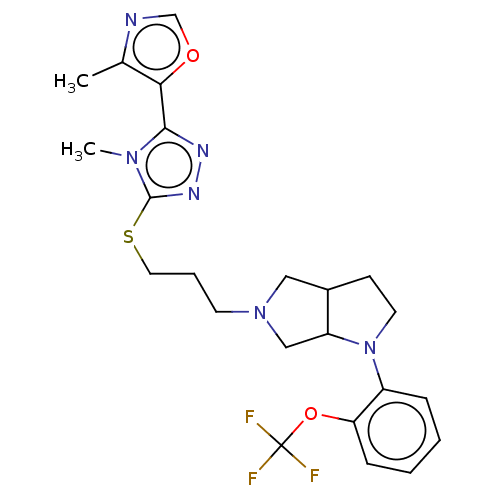BDBM50154891 CHEMBL3775872::US10273244, Example 25::US10584135, Example 25
SMILES Cc1ncoc1-c1nnc(SCCCN2CC3CCN(C3C2)c2ccccc2OC(F)(F)F)n1C
InChI Key InChIKey=ZFACTJHKUXTZMC-UHFFFAOYSA-N
Activity Spreadsheet -- Enzyme Inhibition Constant Data from BindingDB
 Found 9 hits for monomerid = 50154891
Found 9 hits for monomerid = 50154891
Affinity DataKi: 1nMAssay Description:Displacement of [3H]-spiperone from human dopamine D3 receptor expressed in CHO-K1 cell membranes after 90 mins by liquid scintillation counter metho...More data for this Ligand-Target Pair
Affinity DataKi: 1.07nMAssay Description:[3H]-Spiperone Binding Assay at hD3 and hD4 recombinant receptors CHO cells transiently transfected with human dopamine type 3 or 4 receptors (CHO-hD...More data for this Ligand-Target Pair
Affinity DataKi: 1.07nMAssay Description:3H]-Spiperone Binding Assay at hD3 and hD4 recombinant receptors CHO cells transiently transfected with human dopamine type 3 or 4 receptors (CHO-hD3...More data for this Ligand-Target Pair
Affinity DataKi: 4.37nMAssay Description:Functional Calcium Assay at hD2 recombinant receptor. CHO cells stably expressing human dopamine receptor type 2, long variant (hD2L), coupled to G&#...More data for this Ligand-Target Pair
Affinity DataKi: 4.37nMAssay Description:CHO cells stably expressing human dopamine receptor type 2, long variant (hD2L), coupled to Gα16 protein (CHO-Gα16-hD2L) were seeded into b...More data for this Ligand-Target Pair
Affinity DataKi: 20nMAssay Description:Displacement of [3H]-spiperone from human dopamine D2 receptor expressed in CHO-K1 cell membranes after 120 mins by liquid scintillation counter meth...More data for this Ligand-Target Pair
Affinity DataKi: 20.4nMAssay Description:Functional Calcium Assay at hD2 recombinant receptor. CHO cells stably expressing human dopamine receptor type 2, long variant (hD2L), coupled to G&#...More data for this Ligand-Target Pair
Affinity DataKi: 20.4nMAssay Description:CHO cells stably expressing human dopamine receptor type 2, long variant (hD2L), coupled to Gα16 protein (CHO-Gα16-hD2L) were re-suspended ...More data for this Ligand-Target Pair
TargetPotassium voltage-gated channel subfamily H member 2(Homo sapiens (Human))
Aptuit
Curated by ChEMBL
Aptuit
Curated by ChEMBL
Affinity DataIC50: 631nMAssay Description:Inhibition of human ERG tail current expressed in HEK293 cells after 5 mins by patch clamp assayMore data for this Ligand-Target Pair
